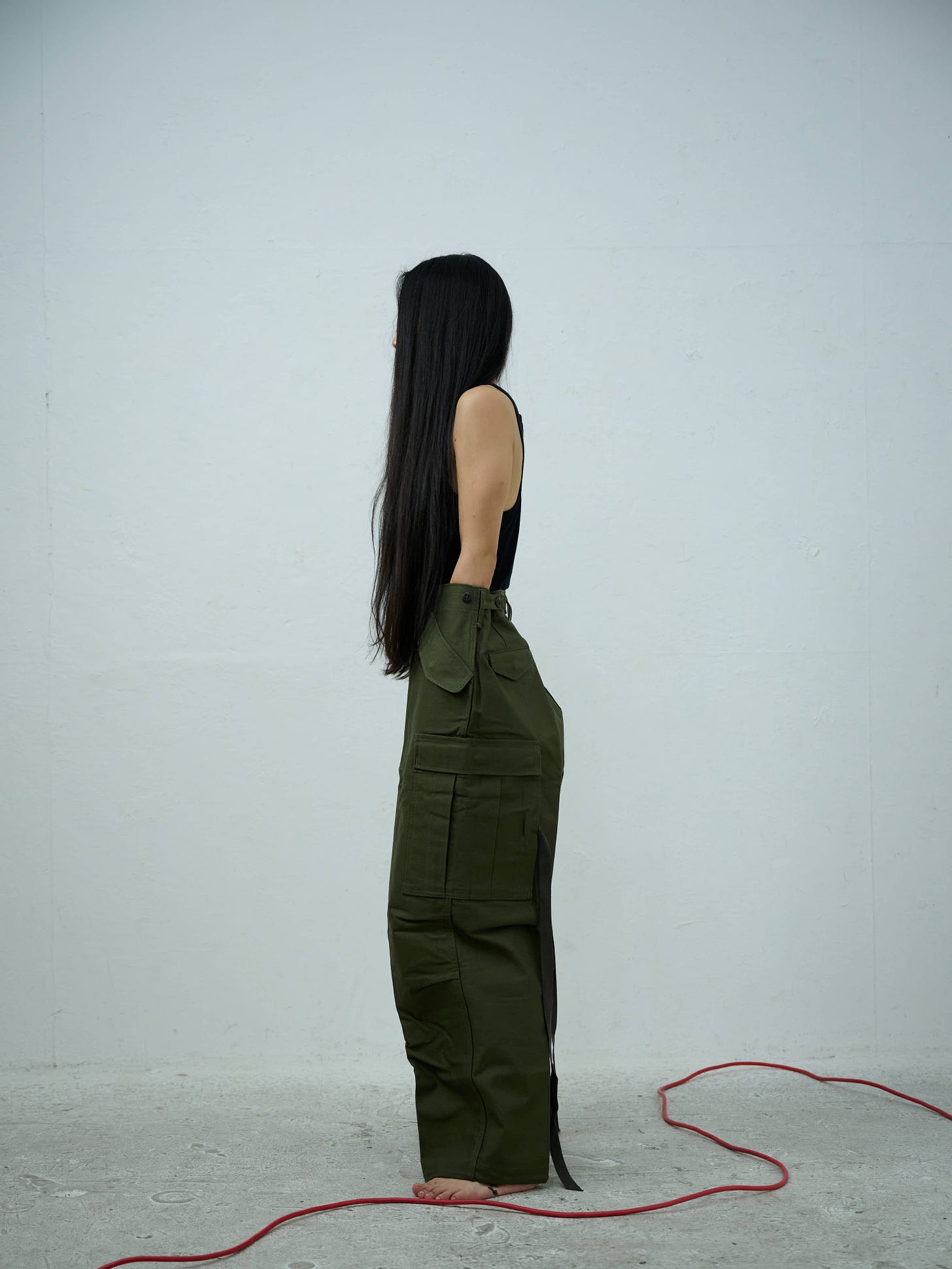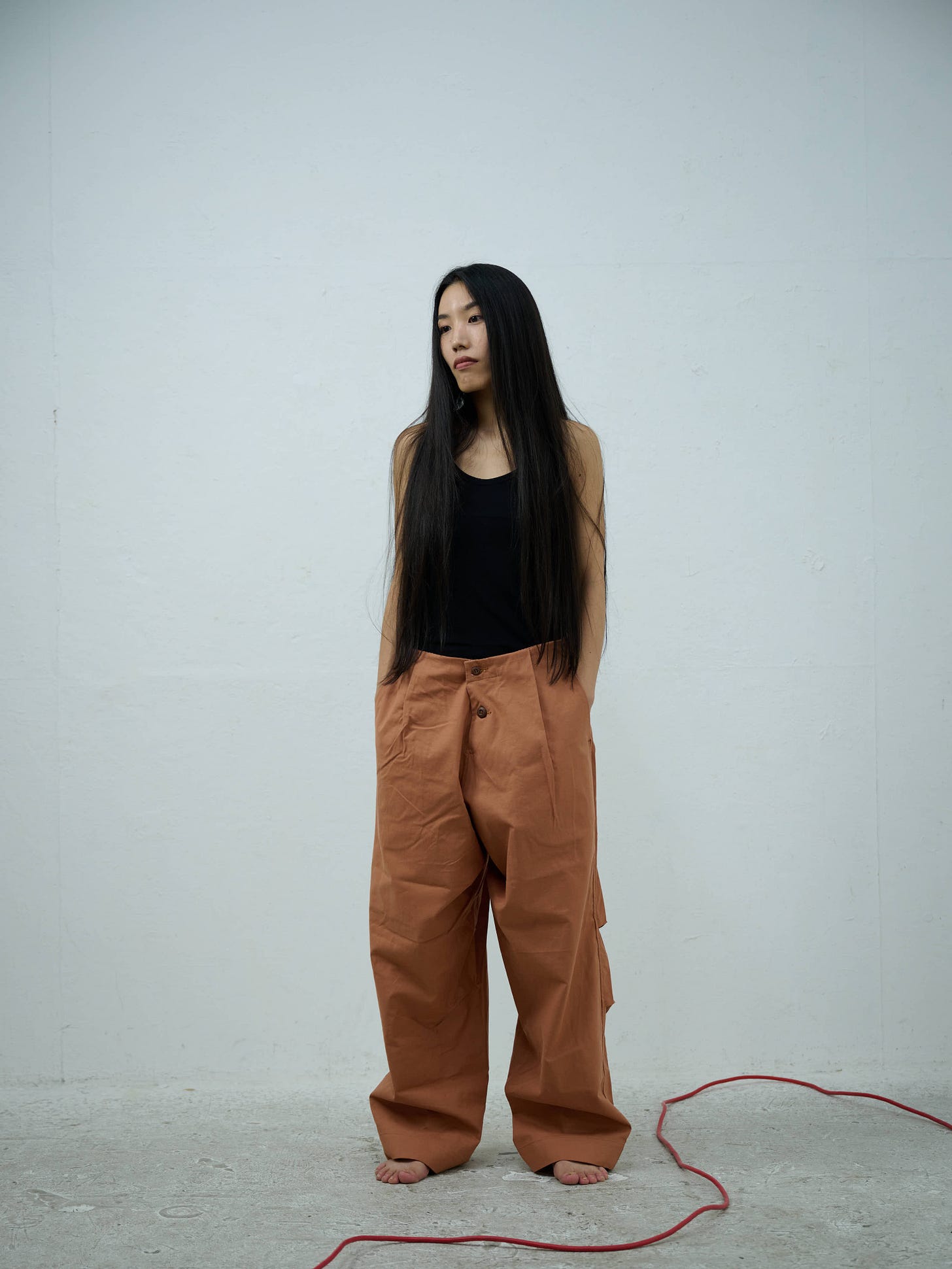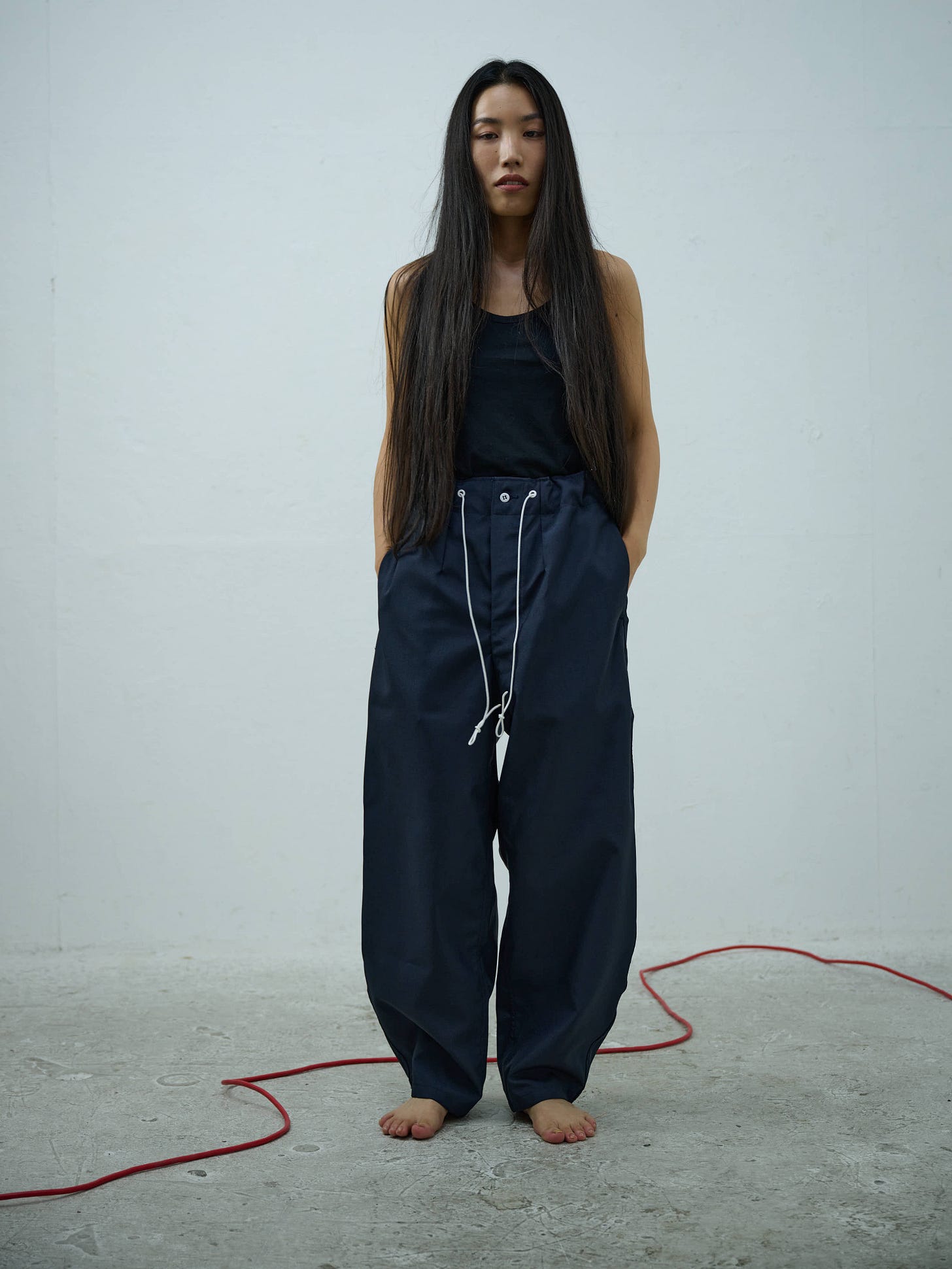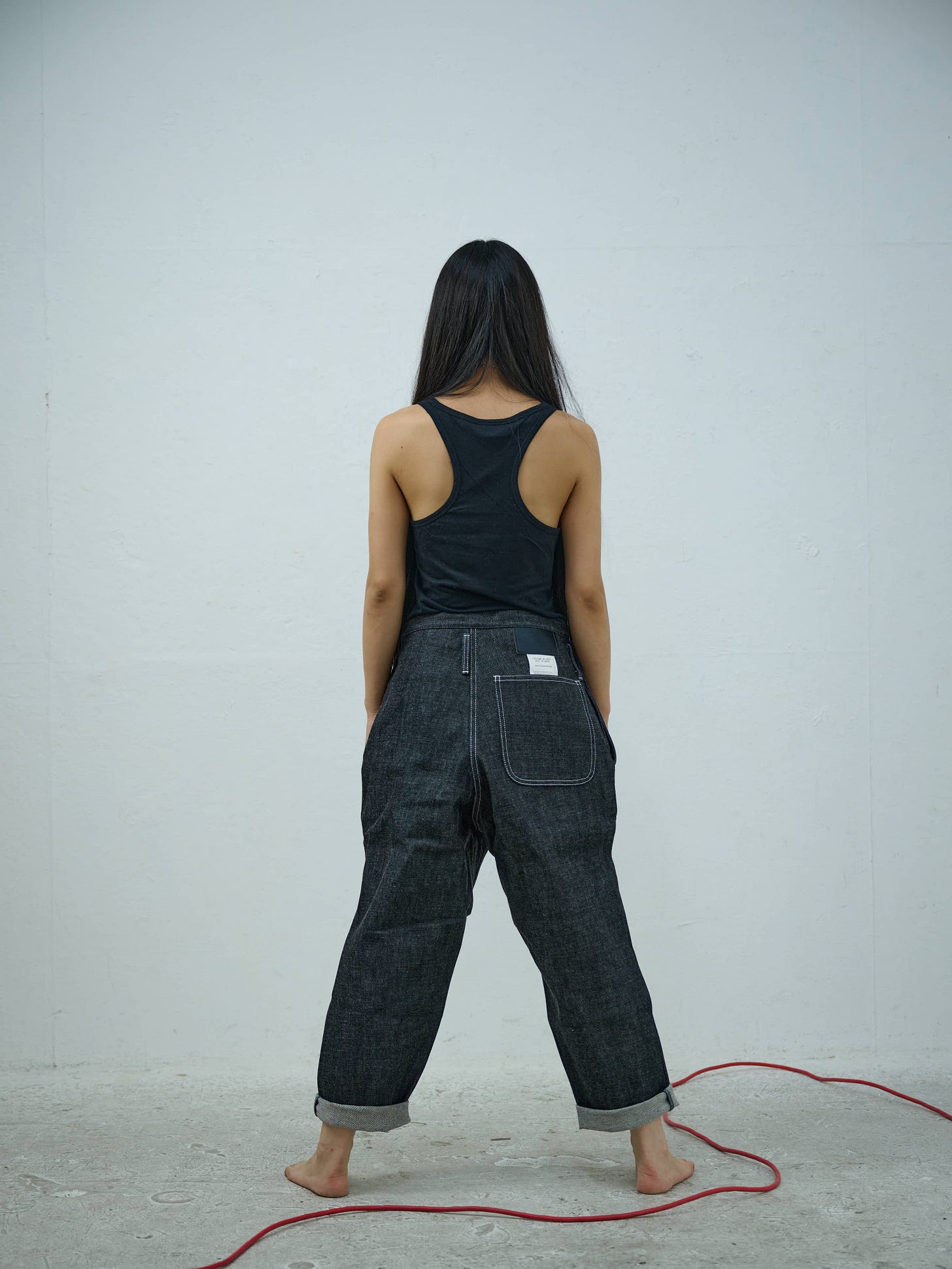TUKI is a Japanese clothing brand founded some twenty years ago, in 2004, by the husband and wife duo Kosuke Harada and Sayoko Noritake. They focus almost exclusively on authentic and eccentric bottoms, ranging from denim jeans to military, sailor and parachute pants — all factory-made in Okayama, Japan. At the core of TUKI’s concept- and research-driven unisex designs stands their unconventional approach to cutting, oriented around body structure. TUKI offers, for instance, overtly baggy silhouettes (‘0054’), back-to-front patterns (‘0041’) and unnecessarily large sizes (‘0154’). At the moment, their items are available only in East Asia (e.g. PUBLIC, SIGNS, LUCA and STORE BROWNIE), but it’s surely only a matter of time before that will change (or so I’d say).
One of TUKI’s most iconic items, to which they return most seasons, is the ‘0054 Type 2 / Salopette’. Made from rope-dyed 14oz (indigo or black) denim, these pants are woven on an air-jet loom, wrapping completely around the body to allow for a super loose fit.
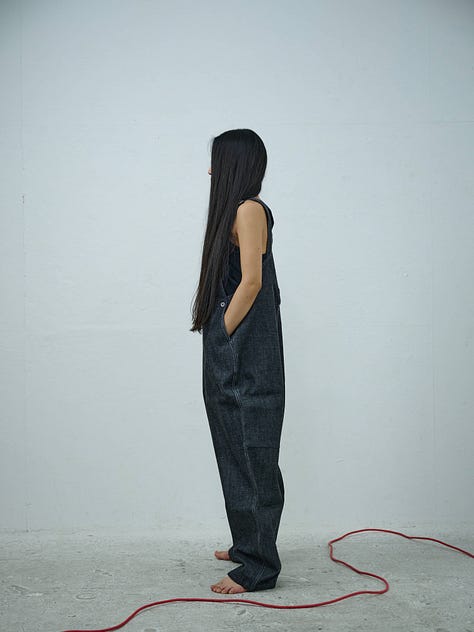
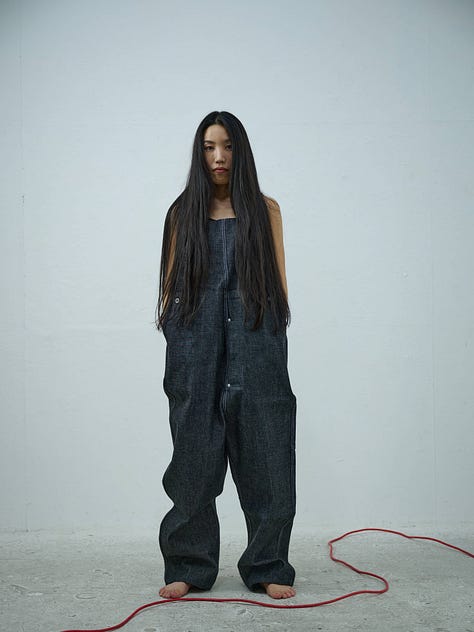
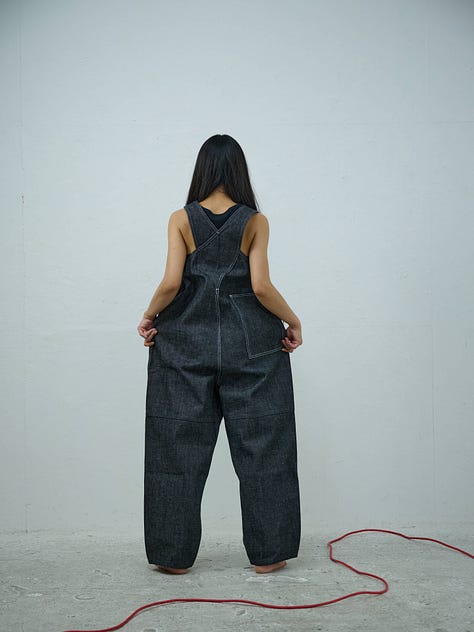
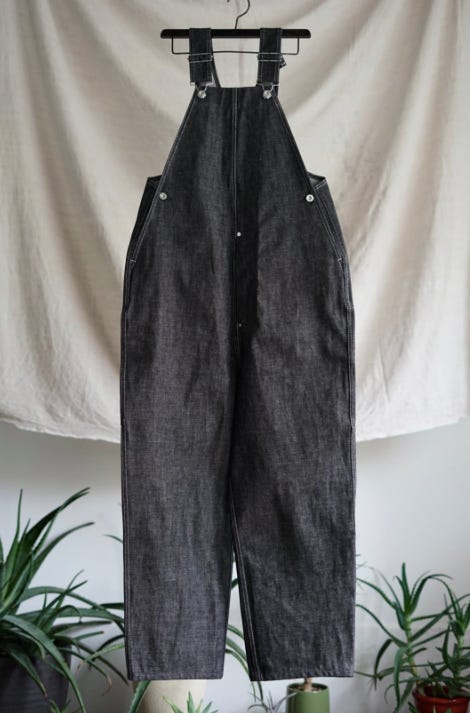


When I approached Kosuke Harada to ask for an interview, his first response was rather frank: ‘Let me ask you, have you ever worn our clothes?’. Since my answer was ‘no’, I was afraid he would turn me down immediately. Instead, he asked me tell a little bit more about myself. As soon as we found out we both had come to clothing from an academic background, we were good to go. What followed was an equally open and honest conversation about Kosuke’s personal story behind TUKI.
PRESENT FOREVER (PF): I always start by asking about the origins and history of a brand. I want to do the same today. When and why was TUKI founded? And could you tell me something about the ambitions behind its establishment?
KOSUKE HARADA (KH): First, let me say that it’s nice to meet you. Here in Japan it’s very rare to find someone in the world of clothing with an academic background. I myself majored in English Literature, but my curiosity led me elsewhere — so perhaps I am just like you.
After my graduation, I had no idea what I wanted to become in the future. But I liked clothes, so I got a job at a small clothing brand in the Kojima district of Okayama, famous for its denim products. At the time, Japan was going through a recession, with stock prices plummeting, and it was difficult to get a job. The brand itself was not well known (in fact, I didn’t even know it myself, but the young president appreciated my knowledge of vintage wear and Western culture). What mattered was that they offered me a wonderful opportunity…
The company had their own sewing factory, and I experienced the assembling of clothes up close. They also had skilled workers in sewing and pattern making, from whom I learned a lot. Rather generously, I was given the chance to familiarize myself with many different kinds of textiles from all over Japan. This is were my knowledge and love of textiles began. (Remember that, unlike today, information was not easily available — Windows ‘95 did not yet exist.)
In other words, I entered the world of clothing with NO professional training. At that company, I learned what was necessary to be able to make clothes. I worked there for about ten years, leaving around 2000 due to mental illness.
PF: What happened after that?
KH: I actually had no intention of getting involved in so-called fashion design. I preferred to become a textile weaver — weaving was something I loved. I felt at ease just talking to the iron loom and experiencing the silence amidst its noise. But my plan was cancelled at the last moment. I was feeling a little better and decided to give designing another try. In fact, there was nothing else I could have done. Luckily, I was supported by an old acquaintance — who works as a fabric merchant — and my wife and partner, Sayoko. And so TUKI was launched in 2004.
PF: What was it that brought you to focus on the design of bottoms? And, relatedly, how did your unconventional concept of (unisex) sizing, characteristic of TUKI, emerge?
KH: Bottoms have always been my favorite piece of clothing. But there are several other reasons for our concentration on bottom design. With the exception of Italian wool pants and selvedge denim jeans, bottoms — especially cotton ones — were not held in high esteem at the time. I wanted to question that situation. Also, and probably like others, I did not consider bottoms to really form a serious part of “fashion design.” Yet, I came to think of them as beautiful objects that can stand on their own. Have you ever heard of Bonsai? Its little world is exactly the same as a huge forest. Anyway, I also had a limited budget, so I chose the way forward that I believed would have the most impact, even though I was still a little doubtful about whether it would actually prove to be good business.
I don’t think that unisex sizing is that unconventional, at least it wasn’t at the time, in the early 2000s. In the vintage clothing world, fashionable girls wore men’s clothes in such a cool way (as did Sayoko!), and I loved those girls. Perhaps what makes TUKI unconventional is that we experiment with different kind of sizings — sizings that are unlike, and sometimes go far beyond, standard “straight”, “loose” and “baggy” styles.
PF: Could you say a bit more about the under-appreciation of bottoms around the time you started TUKI? Are you referring to the situation in Japan specifically, or the world of fashion more broadly?
KH: I remember that this was the case in Asia as well as in the rest of the world, from the 1990s to around 2000. In that period, I went to the U.S. and Europe for business every year. This was when Martin Margiela was doing great work and the first Levi’s RED was launched [in 1999 — the brand’s premium label, dedicated to reinventing its workwear heritage, PF]. Likewise, there was ZUCCA TRAVAIL, designed by Akira Onozuka, which presented great collections of affordable workwear clothes that inspired many other designers. The thing is that until then, “high-fashion” and “vintage” casual wear were very much separated from each other. But this was starting to change. LEVI’S RED iconic reinvented 5-pocket jean was a stand-alone product. I first saw them at BROWNS in London, and was quite shocked.
PF: Let’s zoom in on one of TUKI’s original designs: the ‘0032 Type 3 Jeans’. [See images below] These are very special, I think. When and how did the idea for these pants emerge?
KH: I think it was around 2000 that I first designed the 0032. Not long before that, I had become interested in the notion of distorted and exaggerated silhouettes. I don’t think it was groundbreaking in terms of pattern-making. It is something you see often at Comme des Garçons, for instance. The idea came to me when I was attempting to create a sculptural, three-dimensional silhouette that departed from standard conceptions about what a jeans is, or can be. It was when for the finished silhouette I used a heavy-ounce rigid denim that I felt I had created a completely novel kind of pants. (From the start, we also honestly believed and said to ourselves: “These might be hard to sell.”) I like to surprise people. But I also like, and actually prefer, designs that have the potential to turn into the new standard.
PF: Could you say a bit more about why you don’t consider the 0032’s innovative?
KH: It’s a self-adapted version of the draping method. The silhouette I was looking for was the “extra space” that appears when you’re wearing oversized pants. I wanted to deform the space between the human body and the fabric. It was not that I was inspired by a specific Comme des Garçons product. It was more that I took note of the strange shapes they were already presenting. I think Yohji Yamamoto is a genius at creating such “spaces.” I’m not a pattern-making specialist, but as a designer I am very observant. I’ve always struggled with self-made patterns, and was relieved to discover that I could create something unique…



PF: What you say makes me think of TUKI’s self-description: “authentic and eccentric”…
KH: Yes, good point. As far as I know, many of the things that are now considered “authentic” were once “eccentric”, aren’t they? This holds for jazz and rock ‘n roll, and even for women wearing pants. For me, the words are not opposites — in fact, they are synonymous. To create something authentic, you need an eccentric attitude. And to create something eccentric, you need to understand authenticity better than anything else.
PF: A map on your website shows that TUKI is currently only available in Asia. Is that a deliberate choice?
KH: Of course, if there is a store interested in TUKI, and we are interested in them, we are always ready to export our products, no matter where it is located. But we do not have a contract with a sales agent, for instance. And there is actually very little practical benefit in going abroad to sell our products ourselves. So, in one word: ’troublesome’…LOL. We don’t want to become a global brand. Today, global often means “average,” and I feel that designers and stores have become too average and too easy to understand. We simply want to be an exciting brand both for ourselves and for our existing customers.
Outside of Asia, there used to be great stores that shared our values, like South Willard in Los Angeles (now an art gallery that doesn’t sell clothes anymore). That may have been a lucky encounter. These days it’s really rare to meet such attractive buyers.
PF: Last but definitely not least: your partner (with whom you also create items under the name NORITAKE/HARADA.) Why and how did she become involved in TUKI?
KH: Sayoko studied a bit of fashion at junior college, and worked for the same brand as I did, designing women’s wear. We got married just before I left the company. She doesn’t have any particular technical skills — what she has is good taste. She also frequently visited Paris and Milan for business, so she also obtained a panoramic view of clothing. She quit her job and joined TUKI a few years after I started the brand. We are still working together today.
We started the brand NORITAKE/HARADA in 2019. This has proven quite a challenging experiment. We started it as an attempt to make items in a very wide size range, without creating much variations in design. The idea was to copy the size variations that Levi Strauss used in the 1940s. We also wanted to create “quieter” and more “understated” designs than we had done for TUKI up to that point. And NORITAKE/HARADA also makes jackets, for instance. As said, it’s an experiment. We don’t regularly produce new items. Instead, we think of it as “delicate mass-production”. The same holds for TUKI, actually.
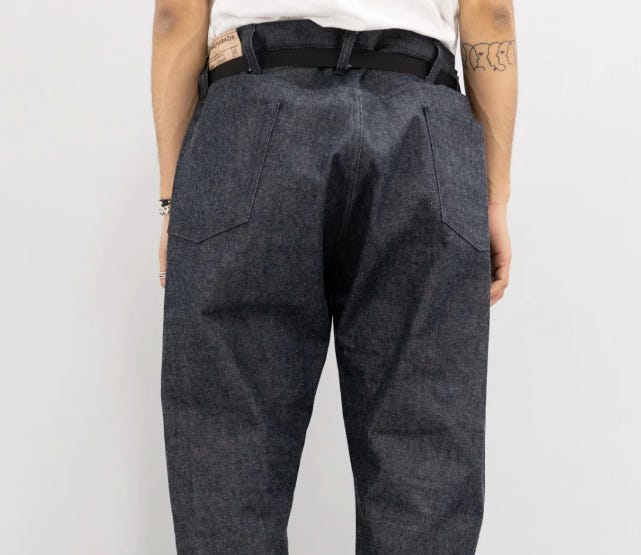



PF: Yes, I read that all of TUKI’s items are deliberately mass-produced in a factory. At the same time, TUKI is widely praised for the high quality of the fabric and construction. Do you see a tension there?
KH: Good question. I don’t know. I think “quality” is often used too quickly and too easily. I know for a fact that it’s hard to control quality in a factory, but that’s exactly why I like it. There are too many stores in Japan that take pleasure in describing expensive, highly technical products in great detail. To me, that’s like going to a movie of which you already know the ending. Or like a comedian explaining which part of a joke is funny. What I want to sell is not a guarantee, but a risky adventure! Unlike artisanal designers, who explain their items themselves, I want to create a situation where someone says: “I just can’t explain why this product is so great!”
PF: Haha, I believe I’m starting to understand what TUKI is all about! Thanks so much, Kosuke.
KH: My pleasure.
——————
FURTHER READING:
Brand in Focus | Pt. 8: DA’S (JP)
Brand in Focus | Pt. 7: SCHEPERS BOSMAN (NL)
Brand in Focus | Pt. 6: ISSEY MIYAKE PLANTATION (JP)
.
What led you to focus on the design of bottoms mostly? And, especially, how did your unconventional conception of unisex sizing emerge?
I had the backing of an old acquaintance, a fabric merchant, and my partner.
And so TUKI was launched in 2004.
I was determined to "just start over from the beginning."
After a while, my wife and partner, Sayoko, decided to work with me
It was exciting to learn how to sew and do patterns, and they rather generously gave me the chance to become knowledgeable of many kinds of textiles from all over Japan. During this period I acquired my knowledge and love of textiles. The
In other words, I had NO professional training in design or pattern making, and working there gave me the knowledge and experience to make clothes.
The company had skilled workers in pattern making and sewing, so what was important was my deep knowledge and passion for clothes.
Unlike today, information and knowledge were not easily searchable. Windows'95 did not yet exist.
I was a college student majoring in American literature.
I had no particular idea what I wanted to be in the future, but I liked clothes, so I got a job at a small clothing brand.
Perhaps I also wanted to extend my moratorium?
I designed for that company for about 10 years, but I left that company due to mental illness.
After that, I had no intention of getting involved in so-called fashion design, but rather to become a textile weaver, which I loved.
I felt at ease talking to the loom made of iron and the silence in its noise.
But my plan was canceled just before I was about to become a weaver, but I was feeling a little better and decided to give clothing designing another try.
In fact, there was nothing else I could have done.
I had the backing of an old acquaintance, a fabric merchant, and my partner.
And so TUKI was launched in 2004.
I was determined to "just start over from the beginning."
After a while, my wife and partner, Sayoko, decided to work with me.
I always start by asking about the origins and history of a brand. When and why was TUKI founded? (Since you already told me about your background, I’m also curious to hear how you specially got into clothing.) And could you tell me what the original ambitions behind its founding were?
that’s surely about to change.
Only available in Asia — probably not for long — it’s
more about which below!).
TUKI’s unisex items have a greater concept of sizing as it relates to one’s height and body structure.
shorts and from chinos to parachute pants — all made in Okayama Japan. At the core of their concept- and research-driven designs stands the
made with their self-developed fabrics in Okayama, Japan.
Specialized in working with cotton they develop fabrics based on their ideas and research. With an unconventional definition of waist size, TUKI’s unisex items have a greater concept of sizing as it relates to one’s height and body structure.
TUKI is a Japanese fashion brand by duo Kosuke Harada and Sayoko Noritake.
They mostly design bottoms, in a way that is both authentic and eccentric.
Specialized in working with cotton they develop fabrics based on their ideas and research. With an unconventional definition of waist size, TUKI’s unisex items have a greater concept of sizing as it relates to one’s height and body structure.
Their machine-maded garments that are carefully controlled somehow challenges the sensitive beauty of bespoke and vintage garments.
This is what




